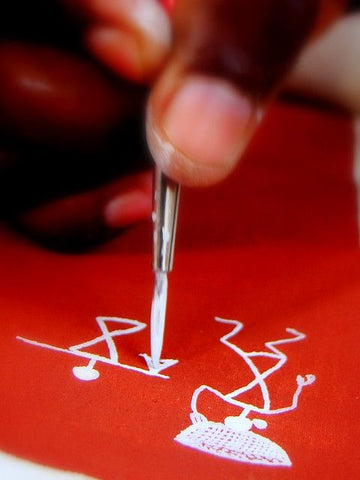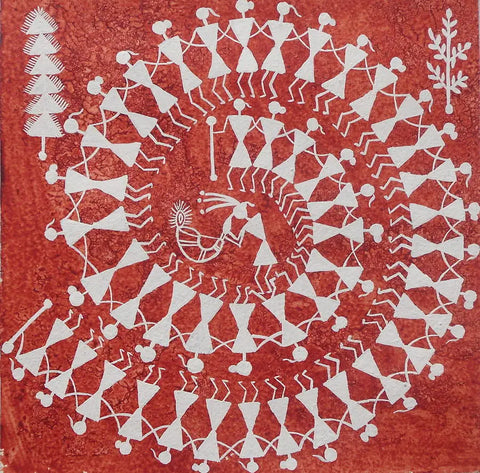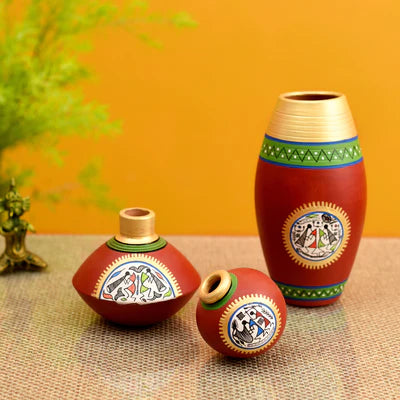The word “ Warli '' brings an image of stick figures and different geometric shapes to our minds. Yes! These paintings are from none other than aamcha Maharashtra! One of the significant Adivasi tribes living outside of Mumbai is the Warli tribe, who originally started the Warli art form.
Warli paintings can be easily spotted around us due to their unique color scheme and patterns. They are white/black colored human stick figures drawn on red/brown backgrounds. The painting's most significant feature is that it represents daily life rather than legendary figures or Gods. The art form is so earthy and adaptable that it can add elegance to a rural mud cottage and make a five-star hotel lobby look luxurious simultaneously.
History
India has a long history of folk arts, preserved by the local tribes living in various corners of different states. The history of Warli Paintings is practically engraved on the walls of India. Warli art is similar to prehistoric cave paintings, and the roots of Warli may be traced back to 2500 to 3000 BCE, based on the book 'Painted World of the Warli' by Yashodhara Dalmia. Traditionally, Warli paintings were used to decorate mud huts and caves from the inside. These paintings gave motivation to the tribals to do good deeds and live harmonious lives.
Exceptional types of Warli painting
Kanna - This is the only variation drawn on the floor, and it is done solely by women since it is a sign of virginity, and it is drawn on the third day of the wedding at the bride's residence.
Muthi - Muthi (also known as the fist) is used to make an impression on the walls of buildings on the day that new rice is delivered from the field for the first time. The same impression may be observed on farmlands, kitchen walls, and even farm machineries, which are said to represent a food surplus.
Devchauk
In Warli Art, square shapes known as 'Chauks' are seen. Devchauk translates to 'God's square' in English (Dev: God, Chauk: square). It is often drawn to represent weddings and Palghat, the mother goddess of fertility, is also sometimes depicted. As the tribe's source of life, she is crucial to this artwork. The figures are participating in a variety of tribal activities, such as hunting, gathering water and picking coconuts from trees, singing, dancing, and playing instruments.
Wonderful Warli feature
1. Warli’s unique design - The Warli paintings are exceptional as they use purely earthy colors applied with charcoal and limestone paste. These paintings have a great flow and symmetry peculiar to the Warlis, reflecting their culture. The basic geometric shapes used in these paintings are a circle, a triangle, and a square. These shapes represent many components of nature. Their observations of nature inspired the circle and triangle. The sun and moon are symbolized by the circle, while mountains and conical trees are symbolized by the triangle. The square, on the other hand, appears to be a man-made concept, signifying a plot of land.
2. Making Warli- The design is chosen first. The design is drawn directly without any roughwork on canvas, paper, cloth, or a wall. Walls, clay pots, wooden products, paper, or linen are painted with white paint. Hands and legs are displayed in dance postures. The rest of the design is finished by painting fine details. The material is ironed on the back side to maintain the color. The Warli just uses a white pigment that is a mixture of rice flour and water, plus a little gum to help it stick together. Bamboo stick’s ends are chewed to be used as a paintbrush.
3. Tarpa Dance- One of the main elements of any Warli artwork is the Tarpa dance. In this, both men and women surround the Tarpa players while entwining their hands. The Tarpa dance is one of the main subjects that is shown in numerous Warli paintings. Different village men take turns playing the Tarpa, an instrument resembling a trumpet. Men and women circle the Tarpa player while intertwining their hands. The dancers follow the Tarpa player. 

Warli is more than an art form
Warli is not just an art form, it's a lifestyle. According to Warli, wildlife and men should live in harmony. In this painting style, this idea and concept are bold and obvious. Putting Warli art on your walls will inspire you to reflect on the tribe's approach to life. If you have Warli art in your house, it would make you feel more connected to nature and respect the wildlife around as well. Warli art is a very classic, simplistic, and elegant way of expression. Warli art is popular in home decor items like exotic vases, cups, traditional warli wall paintings, wall decor ladders, planters, table lamps, trays and handcrafted wall clocks.

Including this type of art will bring a visually appealing, contemporary feel to your house. In both traditional and contemporary Warli art, incredibly delicate colors are used. These shades are calming to the mind and look lovely in any space. Best Warli home decor can be found on iTokri! Go bring home the beautiful range of Warli items that can make any corner of your home earthy and lively.
Keeping the art live
Warli art and Warli paintings have progressed and changed since their origin. The medium and tools used to make the paintings have changed. Watercolors and handmade paper or canvas fabric are currently used by the majority of painters.
Today, Warli art has progressed far enough to be incorporated into contemporary fashion and design concepts. Warli paintings, which were once a basic painting style of a minor Indian tribe, have gained international attention, thanks to our skilled painters and unique Indian handicraft stores. It is truly heartening to witness an old art style, which is also a part of Indian national history, flourishing in current times. Warli paintings have broken gender barriers as well.Warli paintings were made by tribal women, particularly married ladies. Today, there are just as many male artists who are taking up the art and giving it their personal twist.
Blogs you might also like:
All You Need to Know About Dhokra ArtSanganeri Chapai - The Ancient hand block printing Art
The Great Mythological History Of Dhanteras
REFERENCES
https://theasifkamal.com/blog/2017/11/26/warli-art-phase/
https://www.dsource.in/resource/warli-painting/introduction
https://roomfruit.com/warli-painting-art/
https://blog.artlounge.in/blog/2021/8/17/indian-art-form-warli-painting
https://bit.ly/3TJE8Je
https://bit.ly/3RfrUXm
 Verified Purchase
Verified Purchase

















Leave a comment (all fields required)